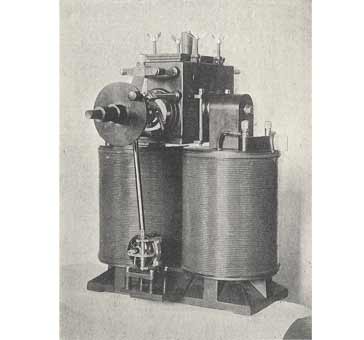Poulsen Arc Transmitter
The Poulsen arc transmitter was different to the spark gap transmitter and was used successfully in a number of installations.
The Poulsen arc transmitter was different to the spark gap transmitter and was used successfully in a number of installations.
Spark Gap Transmitter History Includes:
Spark gap transmitter history
Operation
Poulsen arc transmitter
An arc transmitter is different to a spark gap transmitter. The arc transmitter, sometimes called the arc converter, or Poulsen arc transmitter after Danish engineer Valdemar Poulsen who invented it in 1903.
The Poulsen arc transmitter was a variety of spark transmitter that used an electric arc to convert direct current electricity into radio frequency alternating current. It was used as a radio transmitter from 1903 until the 1920s when it was replaced by vacuum tube transmitters.
The key advantage of the Poulsen arc transmitter was that it was one of the first transmitters that could generate continuous sinusoidal waves.
Unlike the basic spark-gap transmitter, the arc converter produced undamped continuous waves signals. This enabled much narrower bandwidths to be used along with much higher levels of efficiency.
Development of the arc transmitter
As with all developments there were a number of foundations that were set in place before the main invention could be made. The same was true for the Poulsen arc transmitter.
One of the first developments that was fundamental to the arc transmitter was the development by Sir Humphrey Davy of carbon arc lighting in the 1840s. Then in the 1850s outdoor arc lighting became popular as a result of its efficiency and power.
Then around 1890 Tesla and JJ Thompson independently design high-frequency alternators to eliminate carbon arc audio noise. This work was then extended in the 1900s by by Ernst Alexanderson to make the first continuous-wave RF transmitters operating around 50 kHz for Reginald Fessenden.
The development was taken further in 1892 by Elihu Thomson who discovered that an arc powered by DC loaded with inductance and capacitance could produce oscillations. This work was extended by the realisation that the frequency of oscillation and frequency could be increased by applying a magnetic field perpendicular to the arc.
The arc was actually a negative resistance device in which the voltage across the device fell as the current went up.
What is a Poulsen arc transmitter?
The Poulsen arc transmitter consisted of an arc across which was placed a tuned circuit.
The arc converter itself consisted of a closed chamber in which the arc burned in hydrogen gas between a carbon cathode and a water-cooled copper anode. The arc was subjected to a strong magnetic field that was typically provided by two series field coils above and below the chamber that surrounded and energised the two poles of the magnetic circuit. These poles projected into the chamber, one on each side of the arc to provide a magnetic field. An antenna tuning section was needed to suppress the harmonic output of the arc converter.

The Poulsen arc transmitter was typically a very low frequency form of transmitter, which was most effective between frequencies of few kilohertz up to a few tens of kilohertz. The arc transmitter could be adaptable and could be sued for designs of one to five kilowatts for ship-based transmitters up to shore stations that could be up to several hundred kilowatts.
The Poulsen arc transmitter was used in the USA where despite the frequency limitations, the improved transmission reliability enabled high speed Morse code transmissions to be made.
 Written by Ian Poole .
Written by Ian Poole .
Experienced electronics engineer and author.
More History:
Radio history timeline
History of the radio
Ham radio history
Coherer
Crystal radio
Magnetic detector
Spark transmitter
Morse telegraph
Valve / tube history
PN junction diode invention
Transistor
Integrated circuit
Quartz crystals
Classic radios
Mobile telecoms history
Vintage mobile phones
Return to History menu . . .



